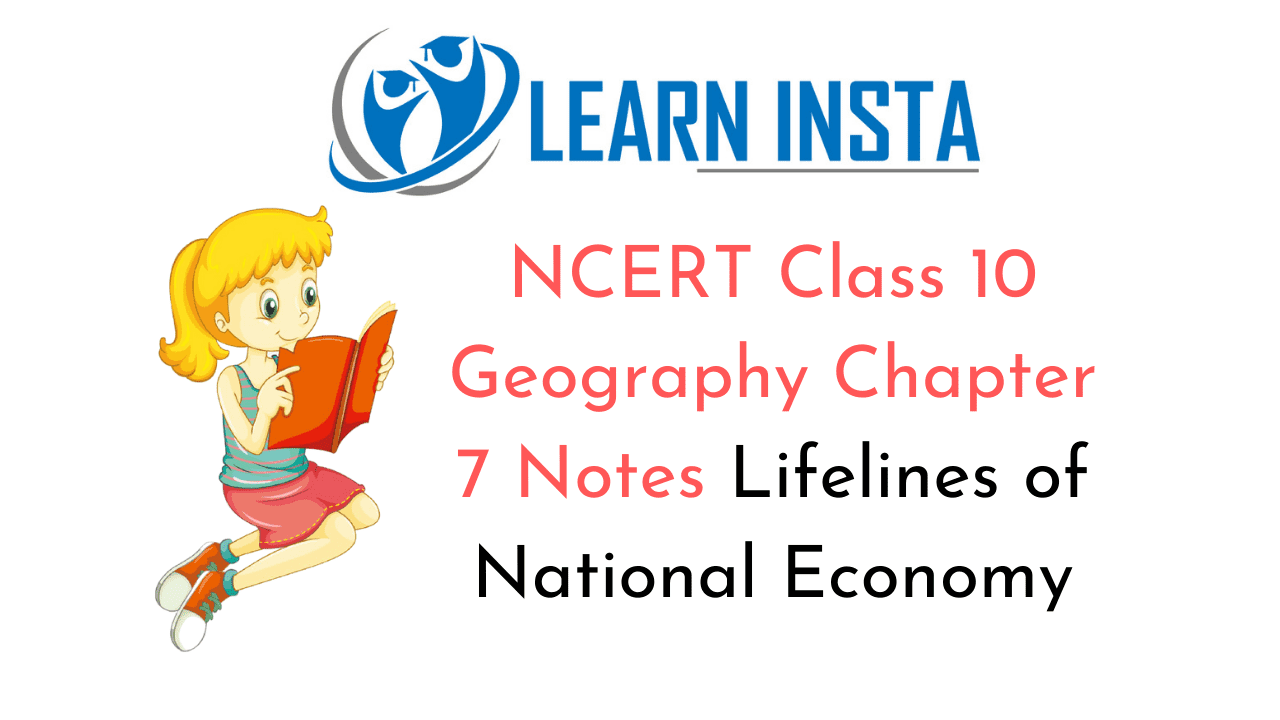 On this page, you will find NCERT Class 10 Geography Chapter 7 Notes Pdf free download. CBSE Class 10 Social Science Notes Geography Chapter 7 SST Lifelines of National Economy will seemingly, help them to revise the important concepts in less time.
On this page, you will find NCERT Class 10 Geography Chapter 7 Notes Pdf free download. CBSE Class 10 Social Science Notes Geography Chapter 7 SST Lifelines of National Economy will seemingly, help them to revise the important concepts in less time.
Lifelines of National Economy Class 10 Notes Social Science Geography Chapter 7
CBSE Class 10 Geography Chapter 7 Notes Understanding the Lesson
1. Movement of goods and services can be other three important domains of our earth-land, water and air. Based on these, transport is classified into land, water and air transports.

2. Today, the world has been converted into a large village with the help of efficient and fast-moving transport. A well-developed communication system has contributed a lot in this regard.
3. Railways, airways, waterways, newspapers, radio, television, cinema and interest, etc., have been contributing to India’s socio-economic progress in many ways.
4. India has one of the largest road networks in the world, aggregating to about 2.3 million km at present. Roads in India are classified in the following classes according to their capacity-Golden Quadrilateral Super Highways, National Highways, State Highways, District Roads, Border Roads.
5. Roads can also be classified on the basis of the type of material used for their construction such as metalled and unmetalled roads. Metalled roads are all weathered roads whereas unmetalled roads get out of use in the rainy season.
6. Distribution of roads is not uniform in the country. Density of all roads varies from only 12.14 km in Jammu and Kashmir to 517.77 km in Kerala as on 31 March, 2011.
7. Railways are the important mode of transportation for goods and passengers in India. They play a major role in activities like business, sightseeing, pilgrimage along with transportation of goods over longer distances.
8. The northern plains of India have a good network of railways. But the hilly terrains of the peninsular region and the Himalayas mountainous regions are unfavourable for the construction of railway lines. It was also difficult to lay railway lines on the sandy plain of western Rajasthan, swamps of Gujarat, forested tracks of Madhya Pradesh, Chhattisgarh, Odisha and Jharkhand.
9. Pipeline transport network is a new arrival on the transportation map of India. These are used for transporting crude oil, petroleum products and natural gas from oil and natural gas fields to refineries, fertiliser factories and big thermal power plants.
10. Waterways are the cheapest means of transport. They are most suitable for carrying heavy and bulky goods. It is a fuel-efficient and environment-friendly mode of transport.
11. Mandavi, Zuari and Cumberjua, Sunderbans, Barak, backwaters of Kerala and tidal stretches of some other rivers are important inland waterways on which substantial transportation takes place.
12. India’s trade with foreign countries is carried from the ports located along the coast. Some major seaports of India are Kandla in Kuchchh, Mumbai, Marmagao, New Mangalore, Tuticorin, Chennai, Vishakhapatnam, Paradwip, etc.
13. Airways are the fastest and the most comfortable mode of transport. It can cover very difficult terrains, dreary deserts, dense forest and long oceanic stretches with great ease. Air India provides international air services. Pawanhans Helicopters Ltd. Provides helicopter services.
14. Modern means of communication serve as lifelines of our national and its modern economy. Personal communication and mass communication including television, radio, press, films etc., are the major means of communication in the country.
15. The Indian postal network handles parcels as well as personal written communications. Cards and envelopes are considered first-class mail and book packets, registered newspapers and periodicals are considered second class mail.
16. India has one of the largest telecom networks in Asia. Not only urban places but even villages in India have been covered with Subscriber Trunk Dialling or STD telephone facility. There is a uniform rate of STD facilities all over India.
17. Mass communication provides entertainment and creates awareness among people about various national programmes and policies. Doordarshan, the national television channel of India, is one of the largest terrestrial networks in the world. It broadcasts a variety of programmes for people of different age groups.
18. International trade takes place through sea, air or land routes. Advancement of international trade of country is an index to its economic prosperity.
19. India has trade relations with all the major trading blocks and all geographical regions of the world. The commodities imported to India include petroleum and petroleum products, chemicals and machinery.
20. Tourism in India is well developed. More than 15 million people are directly engaged in tourism industry. Tourism also promotes national integration, provides support to local handicrafts and cultural pursuits.
Lifelines of National Economy Class 10 CBSE Notes Important Terms
Transport: Act of carrying goods or passengers from one place to another.
Linguistic: Of language.
Lifeline: A thing on which someone or something depends or which provides a means of escape from a difficult situation.
Mass communication: Means of communication through which one can communicate with several people at the same time.
Golden quadrilateral: A network of roads which connects Delhi-Kolkata-Chennai-Mumbai and Delhi by six-lane Super Highways.
National Highways: Broad roads which connect extreme parts of the country.
Road density: The length of road per 100 sq. km of area.
Export: Sending goods or services to another country for sale.
Import: Bringing goods or services into a country from abroad for sale.
Hinterland: The remote areas of a country away from the coast or the banks of major rivers.
Trade: The exchange of goods among people, states and countries.
Harbour: A deep coast of the sea which provides shelters to the seagoing vessels.
Tourism: The commercial organisation and operation of holidays and visits to places of interest.